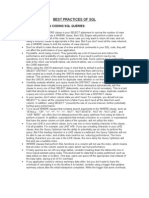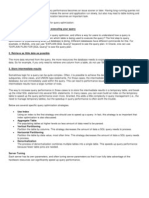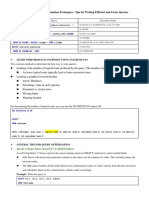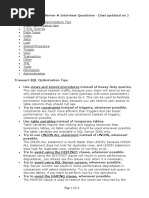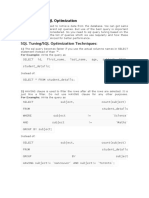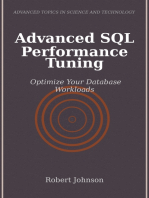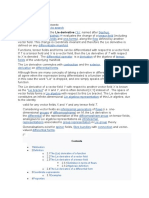SQL-30-Performance-Tips-_-Cheat-Sheet
Uploaded by
postbox181SQL-30-Performance-Tips-_-Cheat-Sheet
Uploaded by
postbox181SQL 30 Performance Tips
Always Test using Execution Plan
CHEAT SHEET
FETCHING DATA AGGREGATING DATA
#1 Only select the columns you need. Avoid using SELECT * #17 Use columnstore indexes for queries involving heavy aggregations on large tables
#2 Avoid using DISTINCT or ORDER BY unless absolutely necessary, as they can slow down queries #18 Pre-aggregate data and store the results in a separate table for faster reporting
#3 For exploration, limit the number of rows using TOP to avoid fetching unnecessary data
SUBQUERIES
FILTERING DATA #19 Understand when to use JOIN, EXISTS, or IN. Avoid IN with large lists as it can be inefficient
#4 Create non-clustered indexes on columns frequently used in the WHERE to speed up queries #20 Simplify your queries by eliminating redundant logic and conditions by using CTE
#5 Avoid functions e.g., UPPER(), YEAR() to columns in the WHERE , as this prevents indexes from being used
#6 Avoid starting string searches with a wildcard (%example), as this disables index usage
DDL
#7 Use IN instead of multiple OR conditions for better readability and performance
#21 Avoid VARCHAR or TEXT types unnecessarily; choose precise data types to save storage and improve performance
#22 Avoid defining excessive lengths in your data types (e.g., VARCHAR(MAX)) unless truly needed
JOINING DATA #23 Use NOT NULL constraints wherever possible to enforce data integrity
#8 Understand the performance implications of different join types. Use INNER JOIN when possible for efficiency #24 Ensure all tables have a clustered primary key to provide structure and improve query performance
#9 Always use explicit (ANSI-style) joins (INNER JOIN, LEFT JOIN, etc.) instead of older implicit join syntax #25 Add non-clustered indexes to foreign keys that are frequently queried to speed up lookups
#10 Ensure that the columns in the ON of your joins are indexed for optimal performance
#11 Filter before joining large tables to reduce the size of the dataset being joined
INDEXING
#12 Aggregate before joining large tables to reduce the size of the dataset being joined
#26 Avoid Over Indexing, as it can slow down insert, update, and delete operations
#13 Replace OR conditions in join logic with UNION where possible to improve query performance
#27 Regularly review and drop unused indexes to save space and improve write performance
#14 Be aware of nested loops in your query execution plan. Use SQL Hints if needed to optimize performance #28 Update table statistics weekly to ensure the query optimizer has the most up-to-date information
#15 Use UNION ALL instead of UNION if duplicates are acceptable, as it is faster
#29 Reorganize and rebuild fragmented indexes weekly to maintain query performance.
#16 When duplicates are not acceptable, use UNION ALL + DISTINCT instead of UNION for better performance
#30 For large tables (e.g., fact tables), partition the data and then apply a columnstore index for best performance results
You might also like
- Pvsyst Tutorial v7 Pseudo Sub Hourly enNo ratings yetPvsyst Tutorial v7 Pseudo Sub Hourly en15 pages
- Daniel 2 and 7 - Equal or Not Equal - Charles Cooper100% (1)Daniel 2 and 7 - Equal or Not Equal - Charles Cooper22 pages
- 6 tips for better sql query optimization (with example code)No ratings yet6 tips for better sql query optimization (with example code)4 pages
- optimizing sql query performance_ a comprehensive guide _ by taran kaur _ women in technology _ mediumNo ratings yetoptimizing sql query performance_ a comprehensive guide _ by taran kaur _ women in technology _ medium15 pages
- 32 Tips For Oracle SQL Query Writing and Performance TuningNo ratings yet32 Tips For Oracle SQL Query Writing and Performance Tuning4 pages
- SQL Performance Tuning: Ch.V.N.Sanyasi Rao, Tiruveedula Gopi KrishnaNo ratings yetSQL Performance Tuning: Ch.V.N.Sanyasi Rao, Tiruveedula Gopi Krishna3 pages
- Top 10 SQL Performance Optimization TechniquesNo ratings yetTop 10 SQL Performance Optimization Techniques1 page
- advanced query optimization techniques in sql _ by darshan lunagariya _ mediumNo ratings yetadvanced query optimization techniques in sql _ by darshan lunagariya _ medium7 pages
- 12 Tips for Optimizing SQL Queries for Faster Performance _ by Sarang S. Babu _ Learning SQL _ MediumNo ratings yet12 Tips for Optimizing SQL Queries for Faster Performance _ by Sarang S. Babu _ Learning SQL _ Medium13 pages
- SQL Server Query Optimization Techniques PDFNo ratings yetSQL Server Query Optimization Techniques PDF9 pages
- 12 sql query optimization best practices for cloud databasesNo ratings yet12 sql query optimization best practices for cloud databases9 pages
- Buy Quest Products Buy Guy'S Book Buy Quest Products: Top Tips For Oracle SQL TuningNo ratings yetBuy Quest Products Buy Guy'S Book Buy Quest Products: Top Tips For Oracle SQL Tuning41 pages
- SQL Query Tuning and Safe Procedure Writing: Submitted By: - Aman SharmaNo ratings yetSQL Query Tuning and Safe Procedure Writing: Submitted By: - Aman Sharma9 pages
- SQL Performance Optimization 1734323939No ratings yetSQL Performance Optimization 173432393917 pages
- Oracle SQL High Performance Tuning: Guy Harrison Director, R&D Melbourne100% (1)Oracle SQL High Performance Tuning: Guy Harrison Director, R&D Melbourne56 pages
- Snowflake Query Optimization Techniques SnowNo ratings yetSnowflake Query Optimization Techniques Snow13 pages
- SQL SERVER 2005/2008 Performance Tuning For The Developer: Michelle GutzaitNo ratings yetSQL SERVER 2005/2008 Performance Tuning For The Developer: Michelle Gutzait112 pages
- SQL Optimization Tips: Select Rows From Sysindexes Where Id Object - Id ( Table') and INDID 2No ratings yetSQL Optimization Tips: Select Rows From Sysindexes Where Id Object - Id ( Table') and INDID 25 pages
- Buy Quest Products Buy Guy'S Book Buy Quest Products: Top Tips For Oracle SQL TuningNo ratings yetBuy Quest Products Buy Guy'S Book Buy Quest Products: Top Tips For Oracle SQL Tuning41 pages
- Advanced SQL Performance Tuning: Optimize Your Database WorkloadsFrom EverandAdvanced SQL Performance Tuning: Optimize Your Database WorkloadsNo ratings yet
- On The Riemann Hypothesis - Gerasimos PergarisNo ratings yetOn The Riemann Hypothesis - Gerasimos Pergaris27 pages
- TheMontessoriElementaryMaterial 10255555No ratings yetTheMontessoriElementaryMaterial 10255555520 pages
- Unit 6 Half_Closed_Eyes_of_the_Buddha_PresentationNo ratings yetUnit 6 Half_Closed_Eyes_of_the_Buddha_Presentation13 pages
- An Introduction To Communication - ORAL COMMUNICATION IN CONTEXTNo ratings yetAn Introduction To Communication - ORAL COMMUNICATION IN CONTEXT20 pages
- Micropython: Bme280 With Esp32 and Esp8266 - Measure Temperature, Humidity, and PressureNo ratings yetMicropython: Bme280 With Esp32 and Esp8266 - Measure Temperature, Humidity, and Pressure19 pages
- Lie Derivative: From Wikipedia, The Free EncyclopediaNo ratings yetLie Derivative: From Wikipedia, The Free Encyclopedia19 pages
- To Be and Have Got Revision Part 1 3 Pages 10 Exer 10238No ratings yetTo Be and Have Got Revision Part 1 3 Pages 10 Exer 102386 pages
- Call Come Do Get Give Go Have Keep Lose Pull Put Take Ring Stick TimeNo ratings yetCall Come Do Get Give Go Have Keep Lose Pull Put Take Ring Stick Time7 pages
- Speak Your Mind Scope and Sequence Level Starter CompressedNo ratings yetSpeak Your Mind Scope and Sequence Level Starter Compressed2 pages




















